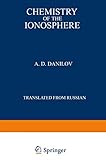Chemistry of the ionosphere Libro electrónico by A. D. Danilov
Tipo de material: Libro
en línea Idioma: Inglés Series Detalles de publicación: New York, New York, United States Plenum Press c1970Descripción: xv, 296 páginas ilustraciones 24 centímetrosISBN:
Libro
en línea Idioma: Inglés Series Detalles de publicación: New York, New York, United States Plenum Press c1970Descripción: xv, 296 páginas ilustraciones 24 centímetrosISBN: - 0306303574
- 9781468417487 (Print)
- 9781468417463 (Online)
- Disponible en línea
Incluye bibliografía e índice: páginas 271-291
1. Results of rocket investigations of parameters of the upper atmosphere.. 2. General outline of elementary processes in the ionosphere.. 3. Rates of processes of dissociative recombination.. 4. Rates of ion-molecular processes.. 5. Ion formation in the ionosphere.. 6. Negative ions and the ionospheric D region.. 7. Oxygen dissociation.. 8. Reactions in which nitrogen and its oxides participate.. 9. Nitrogen dissociation.. 10. Reactions with participation of neutral and ionized hydrogen and helium atoms.. 11. Conclusion.. Index
Disponible para usuarios de ECOSUR con su clave de acceso
I was very happy to learn that Plenum Press has decided to publish an English edition of Chemistry of the Ionosphere. Although the book was largely intended for the Soviet reader in order to fill some gaps in Russian-language reviews on aeronomic problems, I hope that it may be useful to foreign specialists engaged in iono spheric research as well. Naturally, during the time which has elapsed since the preparation of the Russian edition new studies have been published in the world literature on the problems dealt with in this book. The most important of these are noted in the ap pendix to this edition, but some problems (for example, with respect to the physics of negative ions in the lower ionosphere) require a radical reexamination, which cannot be done in a brief appendix. I will be pleased if publication of the book in English will as sist in removing some of the currently existing ambiguities in basic problems of upper atmosphere chemistry. A. D. Danilov Preface to the Russian Edition 1 In the last decade surprising successes have been achieved in the study of the earth's upper atmosphere by use of rockets and artificial satellites. These investigations have made it clear that the upper atmosphere (and particularly the ionospheric region at altitudes 100-1000 km) is a considerably more complex formation than could be visualized prior to the advent of active studies with space vehicles. Inglés
Disponible en línea
Disponible en formato PDF


